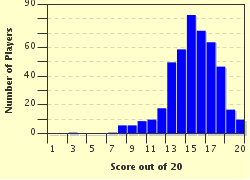Quiz Answer Key and Fun Facts
1. One of the causes of World War Two can be traced back to 28 June 1919. What was this longer-term cause?
2. Which Austrian-born politician became Chancellor of Germany in 1933?
3. In August 1939 a Non-Aggression pact was signed between two countries, shocking the rest of he world and sealing the future fate of Poland. The Pact was between ...?
4. By common consent the Second World War was started when _____________.
5. On 3 September 1939 Britain and France declared war on Germany. Who was the British Prime Minister at the time?
6. After Poland, which of three countries fell in quick succession to the German "Blitzkrieg"?
7. Who was the mastermind behind the brilliant plan to strike at France through the Ardennes?
8. What was the codename of the proposed invasion of Britain?
9. What was the greatest threat to Britain's war effort?
10. The first ever airborne invasion came in May 1941 and was launched against which of these islands?
11. Who eventually stopped and defeated the "Desert Fox" in North Africa?
12. What was the codename for the 1941 German invasion of Russia?
13. 7 December 1941, Hawaii. "Tora! Tora! Tora!" signified which momentous event involving the United States?
14. The US recovered and hit back, dealing the Japanese a devastating blow near an atoll in June 1942. It was the Battle of ...?
15. The first Japanese "Special Attack Corps" was named "Shimpu" but it soon became widely known by the name given to the second corps to be formed, both meaning "divine wind". What was this name?
16. After Germany's surrender on 4 May 1945, Grand Admiral Karl Doenitz's government in Flensburg remained in power for ...?
17. Apart from the Soviet leader, Stalin, who were the other two major Allied leaders at the END of the Potsdam Conference held in July and August 1945?
18. Who was Japan's War Minister and Premier until the final year of the war?
19. In post war Germany the black market flourished and became a major means of survival. What was the most used unit of exchange?
20. "When you go home / Tell them of us and say / For your tomorrow / We gave our today". Where can these famous words be found?
Source: Author
MrRadt
This quiz was reviewed by FunTrivia editor
bloomsby before going online.
Any errors found in FunTrivia content are routinely corrected through our feedback system.

